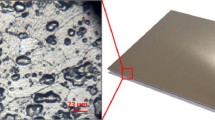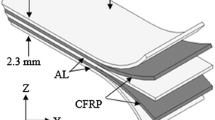Abstract
Carbon fiber reinforced aluminum laminates (CARALL) are one of the aluminum based Fiber metal laminates (FMLs) which, due to their high strength to weight ratio and good impact resistance are greatly replacing aluminum alloys in aircraft structures. In this research work, interlaminate shear strength of Vacuum assisted resin transfer molding (VARTM) manufactured CARALL has been investigated. Numerical simulation model incorporated with real time material data has been developed to predict the delamination behavior of CARALL laminates. Standard CARALL specimens with different surface morphologies were prepared by electric discharge machining, mechanical, chemical and electrochemical surface treatments. T-peel tests were carried out according to standard ASTM D1876-08 to find out inter laminate shear strength. FMLs made out of mechanically, chemically and electrochemically cleaned metal sheets depicted high interlaminate shear strength. SEM micrographs of failed surfaces verify the high adhesive strength of epoxy. Developed numerical simulation model accurately predicts the delamination behavior of CARALL as observed during experimentation.
Similar content being viewed by others
References
Y. Yang and F. Xu, Experimental and numerical investigation on hypervelocity impact response of 2D plain-woven C/SiC composite, Journal of Mechanical Science and Technology, 29 (1) (2015) 11–16.
T. G. Loganathan, R. Krishnamurthy and K. Chandrasekaran, Significance of cyclic loading parameters on the flexural response of the GFRP composites, Journal of Mechanical Science and Technology, 30 (7) (2016) 3127–3136.
R. Ritchie, W. Yu and R. Bucci, Fatigue crack propagation in ARALL® LAMINATES: Measurement of the effect of crack-tip shielding from crack bridging, Engineering Fracture Mechanics, 32 (3) (1989) 361–377.
M. Sadighi, R. Alderliesten and R. Benedictus, Impact resistance of fiber-metal laminates: A review, International Journal of Impact Engineering, 49 (2012) 77–90.
S. Krishnakumar, Fiber metal laminates—the synthesis of metals and composites, Material And Manufacturing Process, 9 (2) (1994) 295–354.
B. Kolesnikov, L. Herbeck and A. Fink, CFRP/titanium hybrid material for improving composite bolted joints, Composite Structures, 83 (4) (2008) 368–380.
T. Sinmazçelik et al., A review: Fibre metal laminates, background, bonding types and applied test methods, Materials & Design, 32 (7) (2011) 3671–3685.
R. Alderliesten, C. Rans and R. Benedictus, The applicability of magnesium based Fibre Metal Laminates in aerospace structures, Composites Science and Technology, 68 (14) (2008) 2983–2993.
M. Mir et al., Review of mechanics and applications of auxetic structures, Advances in Materials Science and Engineering, 2014 (2014).
M. Mir et al., Synthesis and characterization of calcium deficient apatite granules for drug eluting bone graft applications, Ceramics International, 40 (7) (2014) 10719–10725.
G. Abbas et al., Electronic structure and absorption spectra of 6-picoline Schiff base: A DFT and XRD based approach, Journal of Molecular Structure, 1050 (2013) 10–14.
U. A. Khan et al., Investigation of mechanical properties based on grain growth and microstructure evolution of alumina ceramics during two step sintering process, IOP Conference Series: Materials Science and Engineering, 146 (1) IOP Publishing (2016).
A. Asundi and A. Y. Choi, Fiber metal laminates: An advanced material for future aircraft, Journal of Materials Processing Technology, 63 (1) (1997) 384–394.
L. Vogelesang, R. Marissen and J. Schijve, A new fatigue resistant material: Aramide reinforced aluminium laminate (ARALL), Delft University of Technology (1981).
C. Damato, E. Botelho and M. Rezende, Influence of the environmental conditioning on the fatigue behaviour of carbon fibre/epoxy/Aluminum laminates, 13th European Conference on Composite Materials (2008).
M. M. Attar et al., Failure analysis of unidirectional polymeric matrix composites with two serial pin loaded-holes, Journal of Mechanical Science and Technology, 30 (6) (2016) 2583–2591.
H. Nowack and R. Marissen, Recent aspects of crack propagation analyses under variable amplitude loading conditions and prediction methods, International Journal of Materials and Product Technology, 3 (1) (1988) 104–119.
Y. Huang et al., Delamination and fatigue crack growth behavior in fiber metal laminates (Glare) under single overloads, International Journal of Fatigue, 78 (2015) 53–60.
S. Song et al., Experimental and numerical investigation on impact performance of carbon reinforced aluminum laminates, Journal of Materials Science & Technology, 26 (4) (2010) 327–332.
R. Atta-ur-Rahman et al., Demarcation of fatigue crack cumulative damage (initiation+ stage I) of aluminum alloy under combined loading, Life Science Journal, 10 (12s) (2013).
G. Lawcock et al., Effects of fibre/matrix adhesion on carbon- fibre-reinforced metal laminates—I.: Residual strength, Composites Science and Technology, 57 (12) (1998) 1609–1619.
H. S. Kim, B. C. Kim and T. S. Lim, Foreign objects impact damage characteristics of aluminum/composite hybrid drive shaft, Composite Structures, 66 (1) (2004) 377–389.
L. Vogelesang and A. Vlot, Development of fibre metal laminates for advanced aerospace structures, Journal of Materials Processing Technology, 103 (1) (2000) 1–5.
R. Alderliesten, On the development of hybrid material concepts for aircraft structures, Recent Patents on Engineering, 3 (1) (2009) 25–38.
Mudaserullah et al., Fatigue life estimation of different welding zones of oxy acetylene welded aluminum alloy (AA 5052-H32), Nucleus, 50 (3) (2013) 261–265.
T. Figlus and M. Koziol, Diagnosis of early-stage damage to polymer - glass fibre composites using non-contact measurement of vibration signals, Journal of Mechanical Science and Technology, 30 (8) (2016) 3567–3576.
E. C. Seal et al., Method for forming composite structures, Google Patents (1995).
B. J. Jensen et al., Fiber metal laminates made by the VARTM process (2009).
S. J. Yoon et al., AE analysis of delamination crack propagation in carbon fiber reinforced polymer materials, Journal of Mechanical Science and Technology, 29 (1) (2015) 17–21.
W. Asghar et al., Investigation of fatigue crack growth rate in CARALL, ARALL and GLARE, Fatigue & Fracture of Engineering Materials & Structures, 40 (7) (2017) 1086–1100.
E. Baumert et al., Fatigue damage development in new fibre metal laminates made by the VARTM process, Fatigue & Fracture of Engineering Materials & Structures, 34 (4) (2011) 240–249.
N. Karunagaran and A. Rajadurai, Effect of surface treatment on mechanical properties of glass fiber/stainless steel wire mesh reinforced epoxy hybrid composites, Journal of Mechanical Science and Technology, 30 (6) (2016) 2475–2482.
S. Y. Park et al., Recent trends in surface treatment technologies for airframe adhesive bonding processing: A review (1995-2008), The Journal of Adhesion, 86 (2) (2010) 192–221.
W. Brockmann et al., Adhesion in bonded aluminium joints for aircraft construction, International Journal of Adhesion and Adhesives, 6 (3) (1986) 115–143.
Huntsman Corporation, Cold curing epoxy systems, Araldite LY 5052/Aradur 5052 data sheet (2007).
D. K. Aspinwall et al., Electrical discharge surface alloying of Ti and Fe workpiece materials using refractory powder compact electrodes and Cu wire, CIRP Annals - Manufacturing Technology, 52 (1) (2003) 151–156.
M. Gostimirovic et al., Influence of discharge energy on machining characteristics in EDM, Journal of Mechanical Science and Technology, 26 (1) (2012) 173–179.
J. H. Jung and W. T. Kwon, Optimization of EDM process for multiple performance characteristics using Taguchi method and Grey relational analysis, Journal of Mechanical Science and Technology, 24 (5) (2010) 1083–1090.
H. Qaiser et al., Optimization of interlaminar shear strength behavior of anodized and unanodized ARALL composites fabricated through VARTM process, International Journal of Material Forming, 8 (3) (2015) 481–493.
X. Li et al., Interfacial microstructure and mechanical properties of Cu/Al clad sheet fabricated by asymmetrical roll bonding and annealing, Materials Science and Engineering: A, 529 (2011) 485–491.
V. P. Brugemann et al., Fracture toughness testing in FML, A Conference & Exposition on Structural Dynamics, February 19-22 (2007).
Z. Anjum et al., Prediction of non-propagating fretting fatigue cracks in Ti6Al4V sheet tested under pin-in-dovetail configuration: Experimentation and numerical simulation, Materials & Design, 87 (2015) 750–758.
F. Qayyum et al., Numerical simulation of thermal fatigue behavior in a cracked disc of AISI H-11 tool steel, Engineering Failure Analysis, 62 (2016) 242–253.
Z. Butt et al., Generation of electrical energy using lead zirconate titanate (PZT-5A) piezoelectric material: Analytical, numerical and experimental verifications, Journal of Mechanical Science and Technology, 30 (8) (2016) 3553–3558.
A. Maghsoodi et al., Damage detection in multilayered fiber–metal laminates using guided-wave phased array, Journal of Mechanical Science and Technology, 30 (5) (2016) 2113–2120.
F. Qayyum et al., Comparison of thermomechanical stresses produced in work rolls during hot and cold rolling of Cartridge Brass 1101, Materials Science and Technology, 31 (3) (2015) 317–324.
F. Qayyum et al., 3D numerical simulation of thermal fatigue damage in wedge specimen of AISI H13 tool steel, Engineering Fracture Mechanics (2017).
M. Ullah et al., Numerical simulation and experimental verification of CMOD in CT specimens of TIG welded AA2219-T87, Arabian Journal for Science and Engineering, 40 (3) (2015) 935–944.
F. Qayyum et al., The effect of anisotropy on the intermediate and final form in deep drawing of SS304L, with high draw ratios: Experimentation and numerical simulation, IOP Conference Series: Materials Science and Engineering, IOP Publishing, 146 (1) (2016).
N. Anjum et al., Shear strain model for equal channel angular pressing in high elastic extruded plastics, Nucleus, 52 (4) (2015) 169–175.
Z. Butt et al., Investigation of electrical properties & mechanical quality factor of piezoelectric material (PZT-4A), Journal of Electrical Engineering & Technology, 12 (2) (2017) 846–851.
Author information
Authors and Affiliations
Corresponding author
Additional information
Recommended by Associate Editor Seung-Hwan Chang
Zeeshan Anjum completed his B.Sc. in Mechanical Engineering from University of AJK in 2011 and M.Sc. degree in Applied Mechanics and Design from University of Engineering and Technology Taxila, Pakistan in 2014. He is currently doing Ph.D. from the same university.
Rights and permissions
About this article
Cite this article
Khan, F., Qayyum, F., Asghar, W. et al. Effect of various surface preparation techniques on the delamination properties of vacuum infused Carbon fiber reinforced aluminum laminates (CARALL): Experimentation and numerical simulation. J Mech Sci Technol 31, 5265–5272 (2017). https://doi.org/10.1007/s12206-017-1019-y
Received:
Revised:
Accepted:
Published:
Issue Date:
DOI: https://doi.org/10.1007/s12206-017-1019-y




